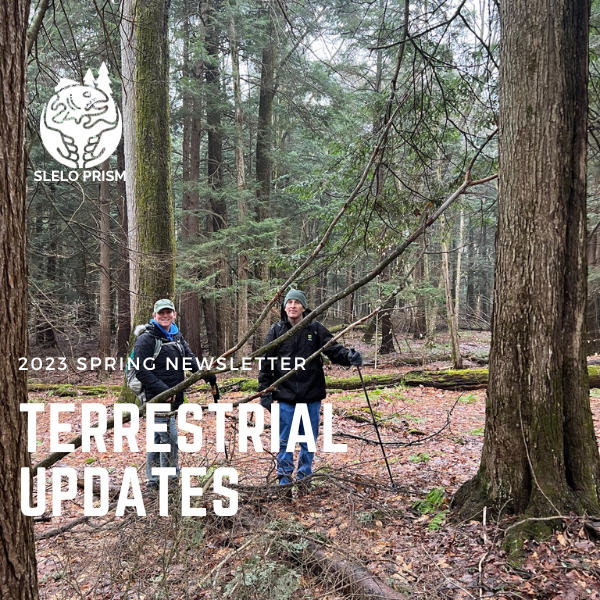This article was featured in the 2023 Srpring Newsletter by Robert Smith-SLELO PRISM.
2023 Hemlock Woolly Adelgid (HWA) Survey Results:
This past winter/fall field season, SLELO PRISM surveyed 18 sites for HWA. 14 of these were completed by the early detection team with some help from volunteers, while 4 were volunteer surveys led by Megan Pistolese-Shaw. Of these 18 sites, none were found to have HWA present. This is good news, but does not exclude the possibility that HWA has arrived recently and just hasn’t reached the lower branches that we inspect or caused thinning in the crown. There was one confirmed HWA site found by OPRHP this year at Battle Island State Park. This brings the total known HWA sites to seven. The other known HWA sites are as follows: Camp Hollis, Independence Park, Mexico Point State Park, Selkirk Shores SP, Noyes Bird Sanctuary, and Oswego County Reforestation Area. The Summary Report will be available soon on the SLELO PRISM website.


Early Detection: Surveys remain on a two-year rotation for our Priority Conservation Areas. This year, Brittney and Robert will return to the eleven sites surveyed in 2021 to include:
- Black Lake
- Delta Lake
- Fish Creek WMA
- French Creek WMA
- Little John WMA
- Mud Lake
- Tug Hill ISPZ
- Upper & Lower Lakes WMA
- Whetstone Reservoir
- Limerick Cedars
- OBI/Three Mile Creek
Four of these PCAs will only have terrestrial surveys, while four PCAs will only have aquatic surveys. Three PCAs will have both aquatic and terrestrial surveys occur this year.
2023 Invasive Species Control Work:
This upcoming field season we plan to treat 90 sites, which is only 1 more than last year. Seventeen sites from last year were retired due to no presence of target species, while 10 sites were removed to determine the need for future management. These sites were all replaced by new sites found in the previous year’s surveys. Changes in the number of each species treated were minimal, with losses/gains of 1 or 2. Deer Creek had the greatest increase in treatment sites, from 6 to 14. This was due to a return to sites that were off-limits in 2022. Three PCAs had the greatest decrease with 3 sites each. This was due to retired sites and sites in review.
As part of DEC’s Giant Hogweed Program, we will be monitoring and treating, if necessary, at 37 sites in Lewis and Jefferson counties. To date, giant hogweed has been eradicated (that is free of giant hogweed for three or more years) at 52% of our sites. Of those eradicated sites, 57% involved manual treatment using the root cut method to reduce the use of herbicides.
Biological Controls for Invasive Species Suppression in SLELO PRISM:
This year, we have several planned biocontrol releases in the SLELO PRISM Area. Starting with Pale Swallowwort, we will again be releasing Hypena opulenta, the moth that feeds exclusively on swallowwort as larvae. Two cages will be set up at Grenadier Island and two cages will be set up at Wehle State Park. This will occur in early June. We are also expanding our overwintering/establishment surveys with planned trail surveys at Wehle State Park and Informal Community Science Surveys on Grenadier Island. We hope to find signs that these moths are surviving and establishing at these sites. Next, we will be conducting our second year of parasitoid wasp releases at Rice Creek Field Station (SUNY Oswego). This will involve the release of 3,000 of the three different species that target Emerald Ash Borer. This will occur throughout the summer and will be followed up by an establishment survey in 2025. Lastly, we are planning to release two biological control species (a silver fly species and a laricobius beetle) at Independence Park starting this year and possibly going into next year.



Restoration:
In 2022, we added a restoration element to management sites where the natural establishment of native species seemed unlikely. In preparation, we surveyed for the presence of native, nonnative, and invasive species presence at four management sites. We followed up in the fall by planting several native graminoids, forbs, and shrubs.
This year, we plan to survey an additional four sites at four PCAs for species presence and plan to follow up with planting in the fall or next year, depending on the amount of reduction in invasive species presence. Follow-up surveys/monitoring will occur at the 2022 restoration sites.

For more information on these or other terrestrial restoration and resiliency projects please reach out to Robert Smith at robert.l.smith@tnc.org


